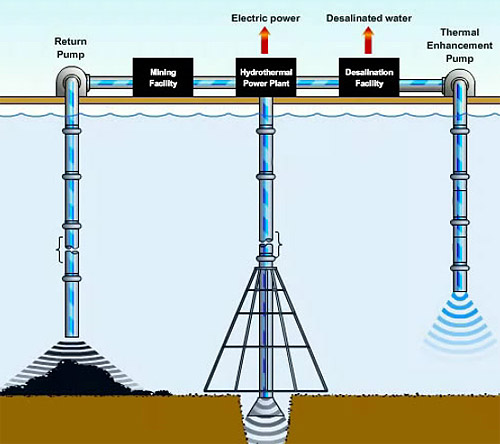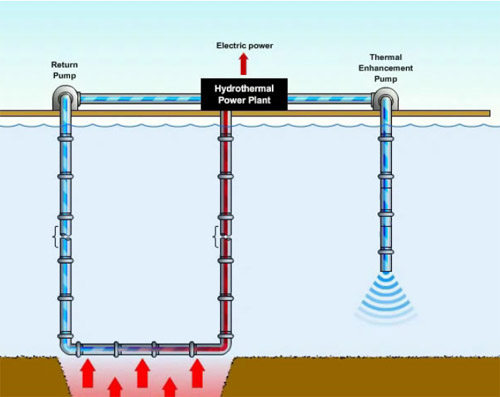Published on September 4th, 2009
Only after I snoozed my way through high
school science class did science become more compelling than
science fiction.
Back then, there was just no compelling reason to pay attention.
Just a browzy fly buzzing in a smelly boring lab full of long
agreed-upon dull principles that were really neither here nor there.
In those days there were no colliding continents or hydrothermal
vents or extremophile lifeforms. We looked to sci-fi for that.
Who knew that our planet would soon be busting at the seams with
7 billion of us. That our fossil fuel use would threaten our
survival with climate changes — on a level unseen on the planet
since Cyanobacteria made it safe it for oxygen-breathers 4 billion
years ago.

Or that we would not only discover vast strange heat
sources under the ocean but that we’d actually consider
mining these hydrothermal vents for renewable energy:
That was the sort of story you’d only find in science fiction back
then.
But yet, here we are. This is not science fiction:
The
energy potential is staggering. In the Gigawatt range per vent.
The Marshall Hydrothermal Recovery System would use the heat from
hydrothermal vents 7,000 feet under the sea to make electricity. Its
temperature is incredibly high, 750 degrees Fahrenheit; hot enough
to melt lead, but it does not boil because of the intense pressures
at the depths where the vents are located.
Superheated fluid would be propelled up through a through a (well
insulated!) pipe to an oil platform located on the surface above the
vent. The superheated fluid is carried by means of flow velocity,
convection, conduction, and flash steam pressure as it rises and the
ambient pressure is decreased.
Once delivered to the platform, the heat energy contained in the
fluid can be extracted to generate electricity. Since the amount of
energy available from any thermal system is dependent on the
difference in temperature between two points, the system also
includes a Thermal Enhancement Pipe.
This is simply an open pipe, like a large drinking straw, which
extends down below the layer of relatively warm water on the surface
to the permanently frigid waters below. By withdrawing water from
that pipe and using it as the cold side of any heat reaction, much
more energy can be extracted from the process than could be
delivered without it.
But what about those extremophile lifeforms down there at
the vent? This has got to be ecologically disruptive!
Marshall Hydrothermal is pretty frank about the horrible
ecological consequences: The company says that there is no
way to sugar-coat the fact that these organisms will die so that we
humans can live our much more exciting lives though electricity.

The company “plans” to relocate the local flora and fauna to another
vent nearby. But can people work 7,000 feet down to carefully pull these
limpet-like creatures off the sides of volcanic vents? I’m not quite
sure how that would happen.
Or, perhaps a closed loop system would be safer?
Marshall offers this alternative method:
Closed Loop Version

This looks a little less invasive: a closed loop system.
Rather than bringing up the hydrothermal fluid itself with bits and
pieces of sea creatures as well, a simple heat exchange is effected
within a closed loop: all the fluid is contained in the pipe and heated
at the vent and circulated up for use to drive the turbines on the
surface.
The cooled fluid is then sent back to be reheated by the vent again
and again, but the hydrothermal fluid itself is never actually brought
to the surface. More than just a huge renewable energy supply is at
stake here.
We could also be making desalinated water from the ocean
vents:
At least 264 million gallons of fresh water daily.
20 million gallons of hot fluid would flash to steam at the surface
and that could be distilled back into fresh water. Further purification
would be needed, but the natural heat from the process itself provides
the most important part of the energy needed for the process. Fresh
water is the new oil.
If even only 50% of the total volume could be recovered, that would
still provide about 264 million gallons of fresh water daily.
Catch 22
Unfortunately, desalination apparently requires the (more
ecologically disruptive) open loop system, to work. (See first diagram)
But, if that could be solved, there is another argument for
mining the actual fluid (open loop); not just the heat (closed
loop) system.
The materials in these geologically ancient vent fluids include iron,
gold, silver, copper, zinc, cadmium, manganese, and sulfur. Halides,
sulphates, chromates, molybdates and tungstates are also abundant.

When the fluid is trapped, the slurry left over after
the heat is extracted can be loaded aboard ships for processing
elsewhere, or processed on-site.
Cap and Trade would also help fund this completely
new form of renewable energy extraction. Who better to carry it out than
the oil industry. They already have the expertize with ocean drilling
extraction.
Turns out there is also significant amounts of methane gas mixed into
the fluid. Maybe there is a way to cap that for remediation-cum-fossil
energy at the same time, as well as selling the renewable electricity,
fresh water and minerals produced by the vents.
For the oil industry, with all these inducements, surely switching to
mining renewable energy would be more cost effective
than having to keep on paying media outlets and school districts and
think-tanksfull of talking heads to keep enough people ignorant enough
about climate change to slow the legislation needed to stop it; decade
after decade.
Let’s hope.
Images from Flikr users
aakova and
thomitheos
Via
Marshall Hydrothermal
a Green Options
Media Production.
Some Rights
Reserved To subscribe or visit go to:
http://cleantechnica.com
|



